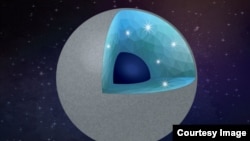Scientists say they have discovered evidence that some planets in the universe could be made of diamonds.
The research centered on exoplanets, planets that orbit a star outside Earth’s solar system.
Arizona State University led the team of researchers. They say some carbon-rich exoplanets likely have the right conditions to hold high levels of diamond. Some of the planets could also be made of silica, a mineral found on Earth in forms such as sand and quartz.
“These exoplanets are unlike anything in our solar system,” said Harrison Allen-Sutter, with Arizona State University’s School of Earth and Space Exploration. He is the lead writer of a study on the findings recently published in The Planetary Science Journal.
The researchers said that stars and planets sharing a solar system form from the same cloud of gas. This means they contain the same minerals.
Earth, for example, orbits the sun, which has a low carbon-to-oxygen ratio. So Earth, too, has a low carbon level, resulting in very small amounts of diamond. The Earth is estimated to contain only about 0.001 percent diamond.
But exoplanets that orbit stars with a higher carbon-to-oxygen ratio than the sun are more likely to be carbon-rich. The researchers suggest that these planets could convert carbon into diamond and silicate if water is also present. This could result in many planets being made mainly of diamonds.
In 2012, scientists announced they had discovered an exoplanet twice the size of Earth believed to be made largely of diamond. Astronomers said the rocky planet, called 55 Cancri e, was likely covered in graphite and diamond, rather than water and granite.
In the new study, the scientists carried out laboratory tests to support their research. They attempted to recreate conditions inside carbon-rich exoplanets with an experiment involving heat and pressure.
The team pressed samples of silicon carbide – a chemical mixture of silicon and carbon – between diamonds in water. Then, to measure the reaction between silicon carbide and water, the researchers used lasers to create high heat.
They used X-ray technology to measure reactions as the sample was heated at high pressure levels. The researchers reported that the high heat and pressure caused the silicon carbide to react with water, turning it into diamonds and silica.
While the study provided new evidence that some exoplanets might contain the highly valued substance, it did not suggest that such planets could also hold life. This is because these carbon-rich exoplanets likely do not have the conditions to support life forms.
The researchers said the inside of such planets would be so hard that they could not be geologically active. A lack of geologic activity would probably make it impossible for the planets to create an atmosphere. Atmospheres are very important for living things because they can provide air and permit liquid water.
Harrison Allen-Sutter said new telescope equipment from the U.S. space agency NASA has helped scientists better observe and learn more about exoplanets than ever before. Astronomers have already confirmed the existence of more than 4,000 exoplanets.
“The more we learn, the better we’ll be able to interpret new data from upcoming future missions… to understand the worlds beyond our own solar system,” he said.
I’m Bryan Lynn.
Bryan Lynn wrote this story for VOA Learning English, based on reports from Arizona State University, The Planetary Science Journal and Reuters. Caty Weaver was the editor.
We want to hear from you. Write to us in the Comments section, and visit our Facebook page.
____________________________________________________
Words in This Story
ratio – n. the relationship between two things expressed in numbers
convert – v. to change the appearance or purpose of something
sample – n. a small amount of something that gives you information about the thing it was taken from
geology – n. the study of rocks and soil and the physical structure of the Earth
interpret – v. explain the meaning of something
mission – n. an important task, usually involving travel somewhere









